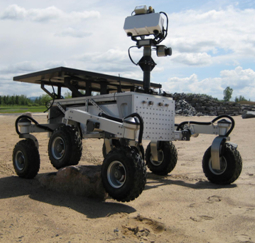The Canadian Space Agency has unveiled terrestrial rover prototypes that mark a milestone in the agency’s robotics work. The prototypes are the early generations of vehicles that will one day explore destinations like the Moon or Mars.
Steve MacLean, the president of the Canadian Space Agency (CSA), and Industry Minister Christian Paradis highlighted the new fleet of prototypes on Oct. 19 at the CSA headquarters in Longueuil, Quebec.
“Canada’s reputation for excellence has been carved out through decades of innovation and technological advances such as the iconic Canadarm, Canadarm2, and Dextre,” Paradis said in a statement.
“That legacy continues with the Next Generation Canadarm and these pioneer terrestrial rovers.”
One of the prototypes, the Lunar Exploration Light Rover, is a mobile moon lab that scoops up samples for analysis using a robotic arm. The largest and fastest rover in the fleet, it can also one day be upgraded to transport humans.
The Kapvik Micro-Rover, named after the Innu word for wolverine, works as a helper for humans, assisting in functions such as digging, while the Mars Exploration Science Rover is a robotic geologist for conducting science on Mars.
The CSA boasts over a dozen more rovers and other equipment developed under its Exploration Surface Mobility project.
The prototypes are tested in the agency’s analogue testing terrain, which replicates the surface of the Moon or Mars. The terrain is the largest of its kind in the world.
The rovers will help define the science and technology that will be required in future space exploration missions that Canada may pursue.
In developing the vehicles, the CSA is collaborating with over 40 organizations across the country from both academia and industry.
The Epoch Times publishes in 35 countries and in 19 languages. Subscribe to our e-newsletter.







